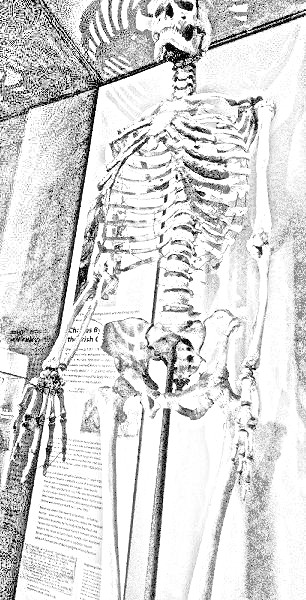
A few days ago the Hunterian Museum announced the decision to remove Charles Byrne from display. I have been watching the case for many years. It’s a fascinating story which was retold by Hilary Mantel in her excellent book ‘The Giant O’Brien’ published in 1998.
Generally, I’m all in favour of human remains on display in Museums. My own feelings is that I’d love my old bones to be displayed in a Museum in a few thousand years time. However, Byrne’s story is particularly poignant and argues the opposite case. Bryne was a giant, he just could not stop growing until he died. He died young and after making a name for himself (as the Giant O’brien) on account of his soaring height. (look at the catalogue entry in the Museum online collection for details of Byrne’s condition.)
John Hunter was the pre-eminent surgeon of the time, and was furiously collecting as many animal and human specimens as he could. Fantastically interested in anything and everything anatomical, he gives a shape to a Doctor Frankenstein figure. For example, his interest in electrical experiment – trying to get dead frogs to twitch with ‘life’ and he had a very active engagement with the Body Snatchers in order to investigate what made someone tall, small, fat, thin, ill, healthy, intelligent, thick, good, criminal and so on.
He pioneered various surgical techniques. Postillions (the people who rode on the horses pulling coaches) were prone to aneurysms as the horses kept squashing their inside leg. Hunter developed an operation to bypass the aneurysm. He tried it out successfully and then kept track of the patient somehow. When the postillion died the Resurrection Men would pay a visit to the local graveyard and dig up the body of the patient. Part of his thigh is on display in the Hunterian Museum (or at least it was the last time I looked). So you can see the success of Hunter’s ground breaking operation – one of wave of surgical developments of the 18th Century. The Hunterian Museum is the museum of the Royal College of Surgeons, and was founded by Hunter.
So, Hunter hears about the Giant O’Brien and finds out he is ill, possibly dying. He has his people keep tabs on him. Charles Byrne is determined not to end up on the anatomist’s slab. So, he organises his funeral in advance paying guards to look after his coffin. He orders a secure iron coffin and in addition, decides to be buried at sea. Because Byrne knows, as an eminent surgeon later on reported to a Commons Committee, that it wasn’t a case of whether the Body Snatchers would get a body but more how much they would have to pay for it if they really wanted it.
But, Byrne thinks he has done enough to die in peace.
Unfortunately, Hunter’s men tracked down the guarded room, and bribed the guards with what would have been a huge amount of money. Byrne was taken back to Hunter’s place, the body melted down, mounted, and was on display until the Hunterian Museum closed for refurbishment recently.
So, a step forward as he is no longer the subject of the public gaze. But in this case we absolutely know that Byrne did not want to be the property of the medical establishment. My own feeling is that he should be given his last wishes and be buried at sea.
Reference collections are very important for Science, and it is for this reason, I am sure, the Museum has not let go of Charles Byrne. But in this case, with this history, an exception should surely be made? He died on 1 June 1783
Discover more from And Did Those Feet
Subscribe to get the latest posts sent to your email.

Amazing story!
Food for thought…